August 2024
North America News
In the US, when hazards are identified in consumer products, they will be recalled and published in the Consumer Product Safety Commission (CPSC) Recent Recalls on the CPSC website, which is updated daily. The US recalls from 01 July 2024 to 31 July 2024 are summarized below:
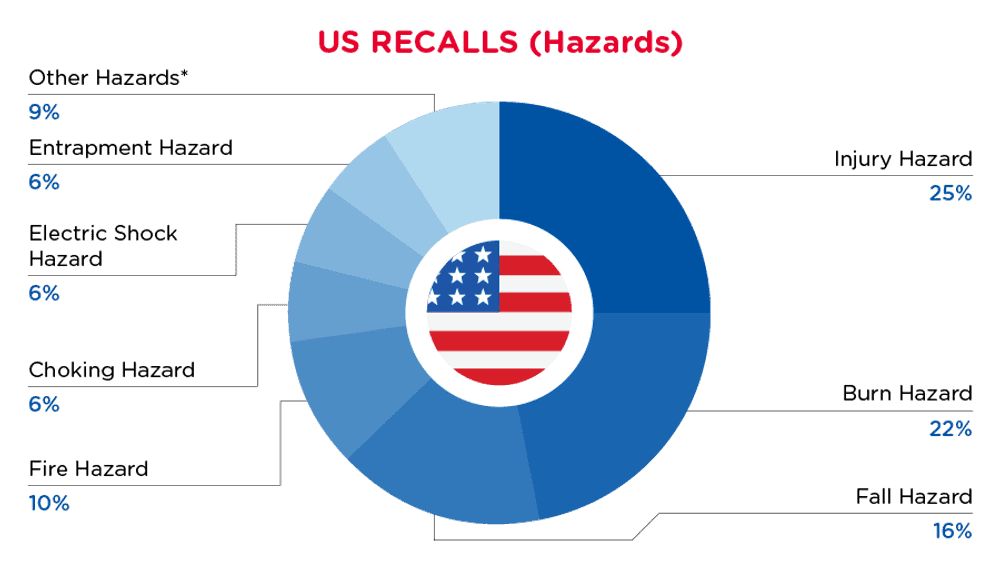
| Hazards | Frequency |
| Injury Hazard | 8 |
| Burn Hazard | 7 |
| Fall Hazard | 5 |
| Fire Hazard | 3 |
| Choking Hazard | 2 |
| Electric Shock Hazard | 2 |
| Entrapment Hazard | 2 |
| Other Hazards* | 3 |
*Other Hazards include Crash Hazard, Poisoning Hazard and Impact Hazard with a frequency of less than 3.

| Product Categories | Frequency |
| Fabric / Textile / Garment / Home Textile | 6 |
| Toys and Childcare Products | 4 |
| Sporting Goods / Equipment | 3 |
| Home Electrical Appliances | 3 |
| Furniture | 2 |
| Outdoor Living Items | 1 |
| Electrical Appliances | 1 |
| Chemicals | 1 |
| Computer / Audio / Video / Other Electronics & Accessories | 1 |
For a complete list click here
In Canada, when hazards are identified in consumer products, they will be recalled and published in the Recalls and Safety Alerts Database on the Health Canada website, which is updated daily. The Canada recalls from 01 July 2024 to 31 July 2024 are summarized below:
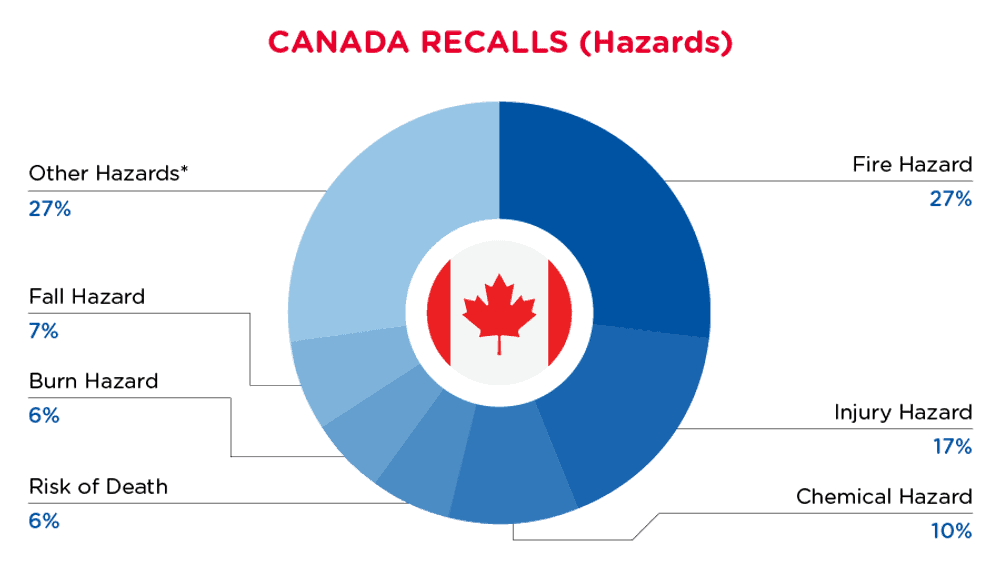
| Hazards | Frequency |
| Fire Hazard | 8 |
| Injury Hazard | 5 |
| Chemical Hazard | 3 |
| Risk of Death | 2 |
| Burn Hazard | 2 |
| Fall Hazard | 2 |
| Other Hazards* | 8 |
*Other Hazards include Safety Risk Hazard, Choking Hazard, Aspiration Hazard, Entanglement Hazard, Ingestion Hazard, Suffocation Hazard, Electric Shock Hazard and Entrapment Hazard with a frequency of less than 2.

| Product Categories | Frequency |
| Electrical Appliances | 6 |
| Toys and Childcare Products | 4 |
| Chemicals | 3 |
| Sporting Goods / Equipment | 3 |
| Home Electrical Appliances | 2 |
| Computer / Audio / Video / Other Electronics & Accessories | 1 |
| Fabric / Textile / Garment / Home Textile | 1 |
| Household Items | 1 |
| Food Contact Material | 1 |
For a complete list click here
Europe News
In Europe, when hazards are identified in non-food consumer products, the products will be recalled and published in the Safety Gate system, which is updated weekly. The European recalls from 01 July 2024 to 31 July 2024 are summarized below:
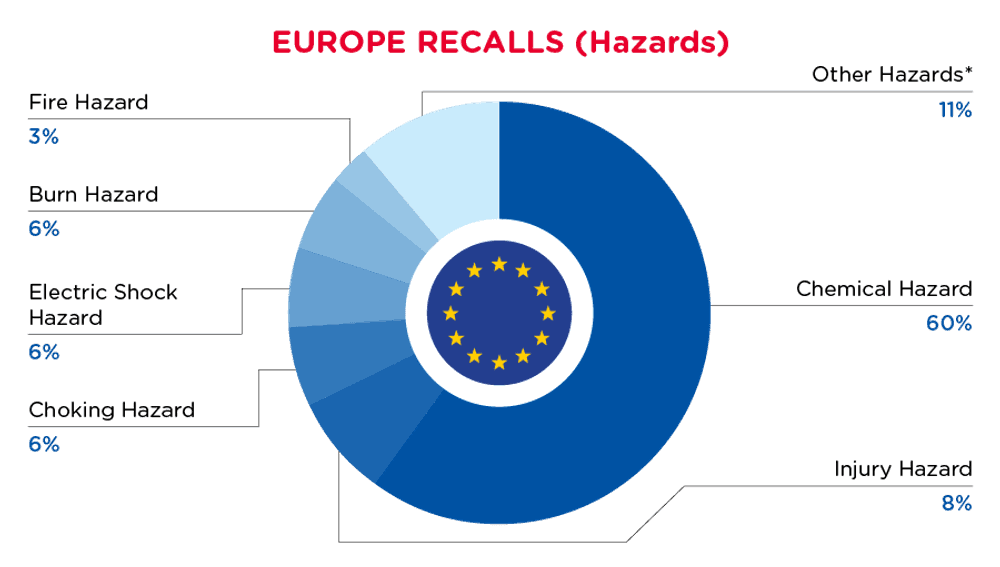
| Hazards | Frequency |
| Chemical Hazard | 163 |
| Injury Hazard | 22 |
| Choking Hazard | 17 |
| Electric Shock Hazard | 17 |
| Burn Hazard | 16 |
| Fire Hazard | 9 |
| Other Hazards* | 31 |
*Other Hazards include Damage to Sight, Environmental Hazard, Cut Hazard, Damage to Hearing, Health Risk Hazard, Microbiological Hazard, Drowning Hazard, Suffocation Hazard, Explosion Hazard, Aspiration Hazard, Asphyxiation Hazard and Strangulation Hazard with a frequency of less than 6.

| Product Categories | Frequency |
| Body care / Cosmetics | 134 |
| Toys and Childcare Products | 35 |
| Electrical Appliances | 18 |
| Machinery | 12 |
| Chemicals | 10 |
| Outdoor Living Items | 10 |
| Other Categories* | 27 |
*Other Categories include Fabric / Textile / Garment / Home Textile, Footwear, Sporting Goods / Equipment, Home Electrical Appliances, Protective Equipment, Car Accessories, Jewelry with a frequency of less than 8.
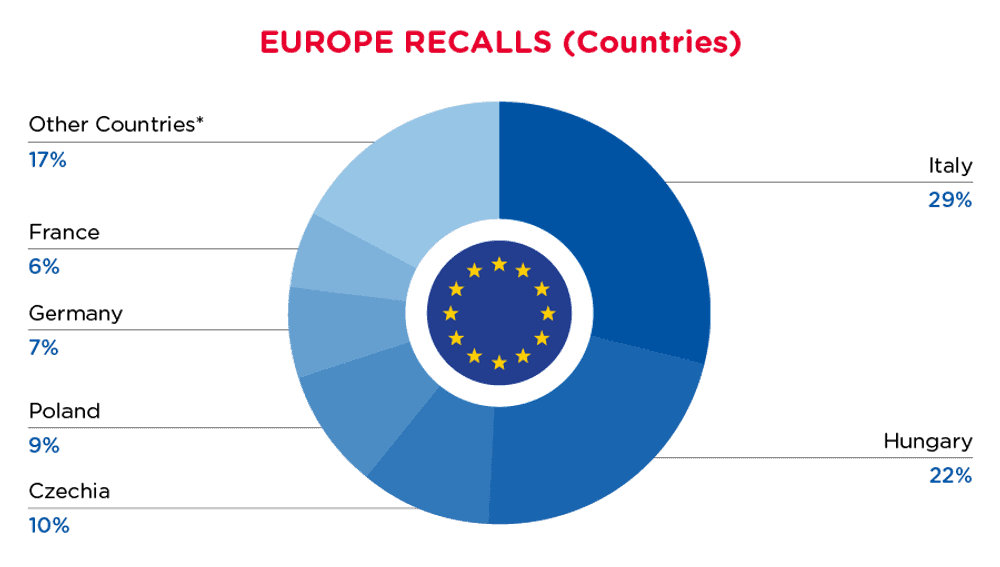
| Notifying Country | Frequency |
| Italy | 71 |
| Hungary | 55 |
| Czechia | 24 |
| Poland | 21 |
| Germany | 18 |
| France | 15 |
| Other Countries* | 42 |
*Other Countries include Finland, Denmark, Lithuania, Spain, Romania, Austria, The Netherlands, Belgium, Bulgaria, Ireland, Slovakia, Luxembourg, Latvia, Cyprus and Croatia with a frequency of less than 7.
For a complete list click here
China News
The State Administration for Market Regulation (SAMR) of China issued Announcement No. 26 which establishes the implementation of China Compulsory Certification (CCC certification) for lithium-ion batteries and chargers used in electric bicycles.
On 2 July 2024, the State Administration for Market Regulation (SAMR) of China issued Announcement No. 26, establishing the implementation of compulsory product certification (CCC certification) for lithium-ion batteries and chargers used in electric bicycles. This initiative aims to strengthen the quality and safety supervision of these products.
Effective Dates:
15 October 2024: Designated certification bodies will start accepting CCC certification commissions for lithium-ion batteries and chargers used in electric bicycles. The certification process will be carried out according to the corresponding mandatory product certification implementation rules and applicable standards.
1 November 2025: Starting from this date, lithium-ion batteries and chargers for electric bicycles must pass CCC certification and bear the CCC certification mark before leaving the factory and being placed on the market.
Applicable Standards
Lithium-ion batteries for electric bicycles must comply with the corresponding GB 43854 standard.
Chargers used for electric bicycles must comply with the corresponding GB 42296 standard.
Designation of Certification Bodies
The announcement also states that the designation of certification bodies and laboratories will be specified under separate regulation.
Effective Date:
The announcement takes effect from 2 July 2024.
This compulsory certification imposes new requirements for market entry concerning lithium-ion batteries and chargers used in electric bicycles. Relevant enterprises must promptly undergo CCC certification to ensure their products meet national standards, which is crucial for improving product quality and ensuring consumer safety.
Reference Link:
https://www.samr.gov.cn/zw/zfxxgk/fdzdgknr/rzjgs/art/2024/art_39caec2eab454e09a47d7212a292555d.html
In China, when hazards are identified in consumer products, they will be recalled and published in the SAMR Defective Product Administrative Centre, which is updated daily. The China recalls from 01 July 2024 to 31 July 2024 are summarized below:
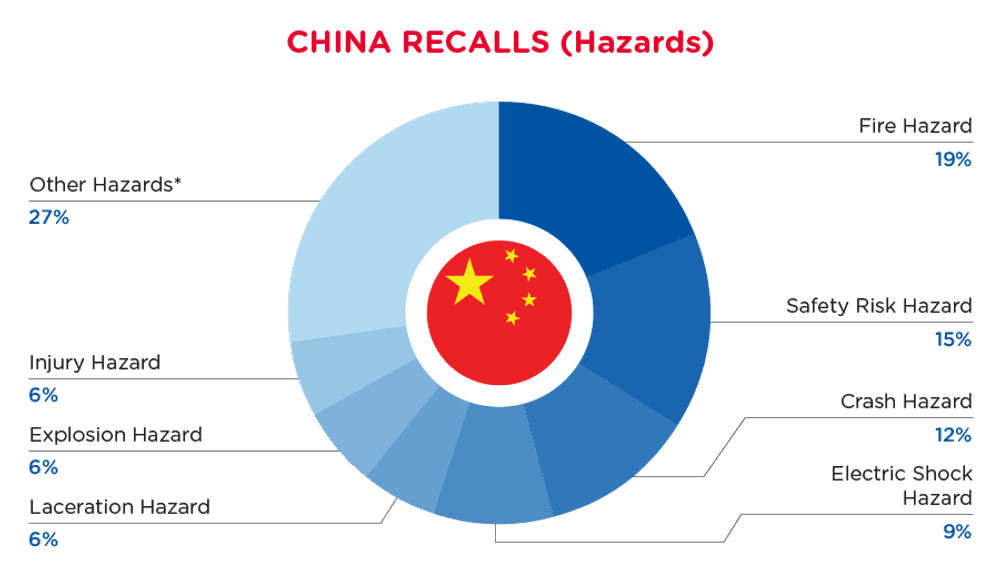
| Hazards | Frequency |
| Fire Hazard | 25 |
| Safety Risk Hazard | 19 |
| Crash Hazard | 16 |
| Electric Shock Hazard | 11 |
| Laceration Hazard | 8 |
| Explosion Hazard | 8 |
| Injury Hazard | 7 |
| Other Hazards* | 35 |
*Other Hazards include Chemical Hazard, Suffocation Hazard, Health Risk Hazard, Burn Hazard, Puncture Hazard, Entanglement Hazard, Risk of Allergy, Strangulation Hazard, Entrapment Hazard, Damage to Hearing, Swallowing Risk, Risk of Exposure to Combustion Flue Gas and Radiation Hazard with a frequency of less than 7.

| Product Categories | Frequency |
| Sporting Goods / Equipment | 21 |
| Electrical Appliances | 17 |
| Toys and Childcare Products | 14 |
| Fabric / Textile / Garment / Home Textile | 9 |
| Food Contact Material | 8 |
| Home Electrical Appliances | 7 |
| Other Categories* | 11 |
*Other Categories include Protective Equipment, Stationery, Tools and Hardware and Outdoor Living Items with a frequency of less than 7.

| Provinces | Frequency |
| Zhejiang | 19 |
| Anhui | 15 |
| Guangdong | 14 |
| Henan | 8 |
| Hebei | 6 |
| Shanghai | 5 |
| Shanxi | 5 |
| Other Provinces* | 15 |
*Other Provinces include Guangxi, Beijing, Hunan, Yunnan, Sichuan, Jiangsu and Inner Mongolia with a frequency of less than 5.
For a complete list click here
Australia/New Zealand News
This mandatory standard ( https://www.legislation.gov.au/F2024L00892/asmade/text) applies to infant products. This mandatory standard was updated on 19 July 2024. There is a transitional period until 19 January 2026 for suppliers to adjust to the new mandatory standard.
Australia updated the Consumer Goods (Infant Products) Information Standard (F2024L00892) on 19 July 2024. General requirements directly from the standard include:
Information to be provided with infant products:
Information relating to the safe use of an infant product must be supplied with the product.
The information must appear in text and include the following:
If the product is not supplied fully assembled:
instructions on how to assemble the product; and
a list of the product’s parts;
If the product can be folded or collapsed without disassembly—instructions on how to fold or collapse the product and the reverse;
If the product is designed to be used with a mattress—the dimensions of the mattress recommended by the manufacturer;
If the height of the product is adjustable—instructions on how to adjust the height of the product;
A warning that consists of the words “WARNING: check this product regularly before using it, and do not use it if any part is loose or missing or if there are any signs of damage. Do not substitute parts. Contact the manufacturer if replacement parts or additional instructions are needed”;
The warning required under section 8 to be marked on the product;
All other relevant information (if any) that relates to the safe use and maintenance of the product.
Markings required for infant products:
An infant product must be clearly and permanently marked with:
If the product is manufactured in Australia or New Zealand:
The manufacturer’s name and address; or
The manufacturer’s trade mark and address; or
If the product is not manufactured in Australia or New Zealand:
The product’s country of origin; and
The Australian importer or distributor’s name.
Warnings:
Warnings required for infant products:
An infant product must be marked with a warning. The warning must:
Appear in text; and
Be clearly visible, prominent and legible; and
Be durable and permanently affixed to the infant product.
The warning must include the following:
The alert word “WARNING” with the letters of the alert word in upper case;
An internationally recognized safety alert symbol that consists of a triangle that is at least 6 millimetres high and has an exclamation mark inside it.
The warning must include statements to the following effect:
Infant should be placed to sleep on a firm, flat surface;
Place infant on their back when using this product;
Do not put objects or accessories in an infant’s sleep environment;
Do not place this product near a blind, cord, strap or similar item that could become wrapped around an infant’s neck.
Additional statements for inclined non‑sleep products:
If the infant product is an inclined non‑sleep product, the warning must also include statements to the following effect:
Do not use this product for infant sleep;
Do not leave infant in this product unsupervised.
Warnings on packaging of infant products:
Warnings for packaging material:
If packaging is supplied with an infant product, the external packaging of the product must be marked with the warning required under section 8 to be marked on the product. The warning must be clearly visible without the packaging being opened.
Warnings for plastic packaging material:
If plastic packaging or wrapping is supplied with an infant product, the plastic packaging or wrapping of the product must be marked with a warning.
The warning must:
Appear in text; and
Be clearly visible, prominent and legible; and
Be durable and permanently affixed to the plastic packaging or wrapping.
The warning must include the following:
The alert word “WARNING” with the letters of the alert word in upper case;
An internationally recognized safety alert symbol that consists of a triangle that is at least 6 millimetres high and has an exclamation mark inside it;
A statement that consists of the words “TO AVOID DANGER OF SUFFOCATION TO BABIES AND CHILDREN, DISPOSE OF PLASTIC PACKAGING IMMEDIATELY”.
Warnings to be displayed online or in store:
If a person:
Carries on a business that supplies an infant product; and
Uses an electronic platform to offer for supply the infant product to consumers;
The person must cause the warning that is required under section 8 to be marked on the product to also be visibly, prominently and legibly included in the infant product’s description provided on the platform.
If a person:
Carries on a business that supplies an infant product; and
Uses a retail premise to offer for supply the infant product to consumers; and
Displays the infant product at the retail premises; the person must cause the warning that is required under section 8 to be marked on the product to also be visibly, prominently and legibly displayed on or near the infant product on display.
Note: There is a transitional period until 19 January 2026 for suppliers to adjust to the new mandatory standard.
This mandatory standard (https://www.legislation.gov.au/F2024L00891/latest/text) applies to infant sleep products. This mandatory standard was updated on 19 July 2024. There is a transitional period of 18 months beginning on the day this instrument commences.
On 19 July 2024, Australia updated the Consumer Goods (Infant Sleep Products) Safety Standard (F2024L00891).
During the transitional period (18 months from commencement of this instrument), an infant sleep product that is a folding cot must comply with either:
The Consumer Product Safety Standard for Children’s Portable Folding Cots (Consumer Protection Notice No. 4 of 2008) as in force immediately before the commencement of this instrument; or
Both:
The requirements in Division 2 of Part 3 (general requirements) of this instrument; and
If the folding cot is a folding cot to which Subdivision B of Division 3 of Part 3 (specific requirements) of this instrument applies—the requirements in that Subdivision.
After the transitional period, an infant sleep product that is a folding cot must comply with both:
The requirements in Division 2 (general requirements); and
If the folding cot is a folding cot to which Subdivision B of Division 3 applies—the requirements in that Subdivision (specific requirements).
During the transitional period, an infant sleep product that is a household cot must comply with either:
The Consumer Product Safety Standard: Children’s Household Cots (Consumer Protection Notice No. 6 of 2005), as in force immediately before the commencement of this instrument; or
Both:
The requirements in Division 2 of Part 3 (general requirements) of this instrument; and
If the household cot is a household cot to which Subdivision C of Division 3 of Part 3 (specific requirements) of this instrument applies—the requirements in that Subdivision.
After the transitional period, an infant sleep product that is a household cot must comply with both:
The requirements in Division 2 (general requirements); and
If the household cot is a household cot to which Subdivision C of Division 3 applies—the requirements in that Subdivision (specific requirements).
After the transitional period, an infant sleep product that is not mentioned in above sections must comply with the requirements in Division 2 (general requirements).
Division 2 general requirement includes:
Incline (horizontal)
Incline (vertical)
Curvature
Surface rigidity
Mattress
Material of sides
Restraint system etc. prohibited
Castors or wheels
Entanglement hazard
Fit for purpose
Locking mechanism
Materials (component requirements)
Entrapment hazard
Small parts
Note: The 18-month transitional period is in effect until 19 January 2026 for suppliers to adjust to the new mandatory standard.
In Australia, when hazards are identified in consumer products, they will be recalled and published in the Recalls and Safety Alerts Database on the Australian Competition & Consumer Commission website, which is updated daily. The Australia recalls from 01 July 2024 to 31 July 2024 are summarized below:

| Hazards | Frequency |
| Injury Hazard | 25 |
| Burn Hazard | 12 |
| Risk of Death | 11 |
| Fire Hazard | 9 |
| Swallowing Risk | 6 |
| Choking Hazard | 6 |
| Laceration Hazard | 4 |
| Other Hazards* | 6 |
*Other Hazards include Risk of Allergy, Ingestion Hazard, Fall Hazard, Skin Irritation Risk, Eye Irritation Risk and Entrapment Hazard with a frequency of less than 2.

| Product Categories | Frequency |
| Electrical Appliances | 6 |
| Toys and Childcare Products | 4 |
| Food Contact Material | 3 |
| Chemicals | 2 |
| Computer / Audio / Video / Other Electronics & Accessories | 2 |
| Fabric / Textile / Garment / Home Textile | 2 |
| Tools and Hardware | 2 |
| Other Categories* | 7 |
*Other Categories include Pet Items, Car Accessories, Body care / Cosmetics, Household Items, Furniture, Sporting Goods / Equipment and Home Electrical Appliances with a frequency of less than 2.
For a complete list click here
Subscribe to our Regulatory Updates
Unsubscribe at any time. Read our privacy policy.